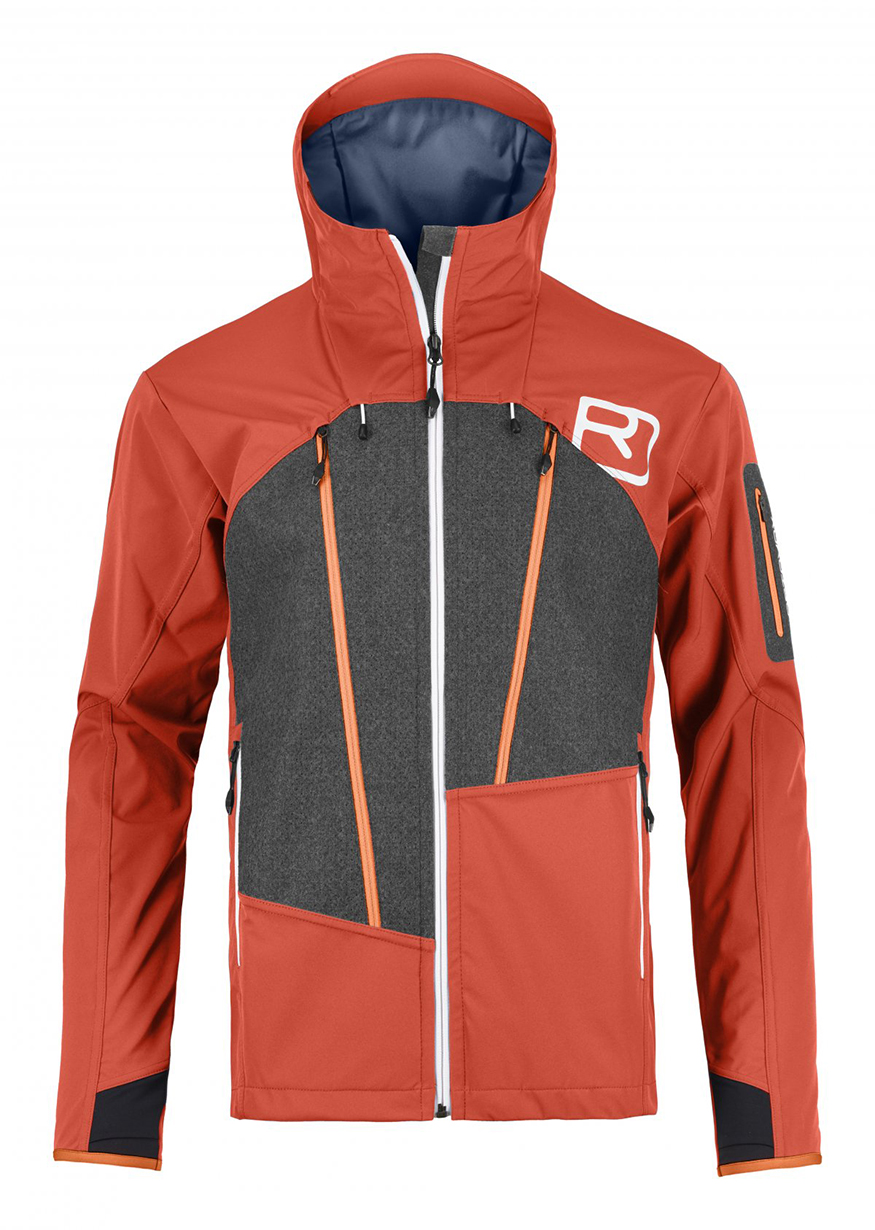
Ortovox Pordoi Jacket
Reviewer: 5’8”, ~155 lbs
Size Tested: Medium
Blister’s Measured Weight: 633 g
Primary Fabric: 3L Schoeller® c_change™ Soft Shell:
- Face Fabric: 86 % polyamide + 14 % elastane
- Membrane: Scholler® c_change™
- Backer: 100% merino wool jersey
Wool Accents: 3L “Loden Punchhole” (Felted Wool w/ Schoeller® c_change™ Membrane)
Stated Features:
- 100% Merino on skin
- Thumb loops
- Ergonomic cut
- Underarm zip vents
- 2-Way adjustable storm hood
- Elasticated Cuffs
Pockets:
- 2 zippered chest pockets
- 2 zippered hand warmer pockets
- 1 zippered bicep pocket
MSRP: $500
Test Locations: Cameron Pass & Rocky Mountain National Park, CO; Lake Louise Ski Resort & Rogers Pass, Canada.
Days Tested: 15
Intro
Ski touring asks a lot of a shell: it needs to breathe well enough to handle exertion on the skin track, be weather resistant enough to fend of the precipitation you’ll inevitably encounter, and include a useful feature set while minimizing weight.
With such broad performance requirements, touring shells vary a lot — from fully-featured, impenetrable Gore-Tex hard shells to minimal, airy soft shells. The Ortovox Pordoi Jacket is the brand’s “premium soft shell” touring jacket, and its unique fabric, generous feature set, and versatile fit make it an intriguing option for an all-around touring jacket. I’ve used the Pordoi Jacket in a variety of conditions and locations to get an idea of how it compares to the many different types of shells on the market, and can now weigh in on how it’s performed.
Fit
I’d say the Pordoi Jacket fits somewhere between slimmer touring jackets like the Norrona Lyngen Hybrid Jacket and baggier resort / freeride shells like the Strafe Pyramid. The sleeves on the Pordoi, however, are a bit tighter than the Lyngen Hybrid Jacket’s, and they taper down to the narrow cuffs that I’ll discuss later. The Pordoi is longer than the Lyngen Hybrid Jacket and the torso has enough room for a base layer and midweight mid layer like the Patagonia Micro Puff Hoody.
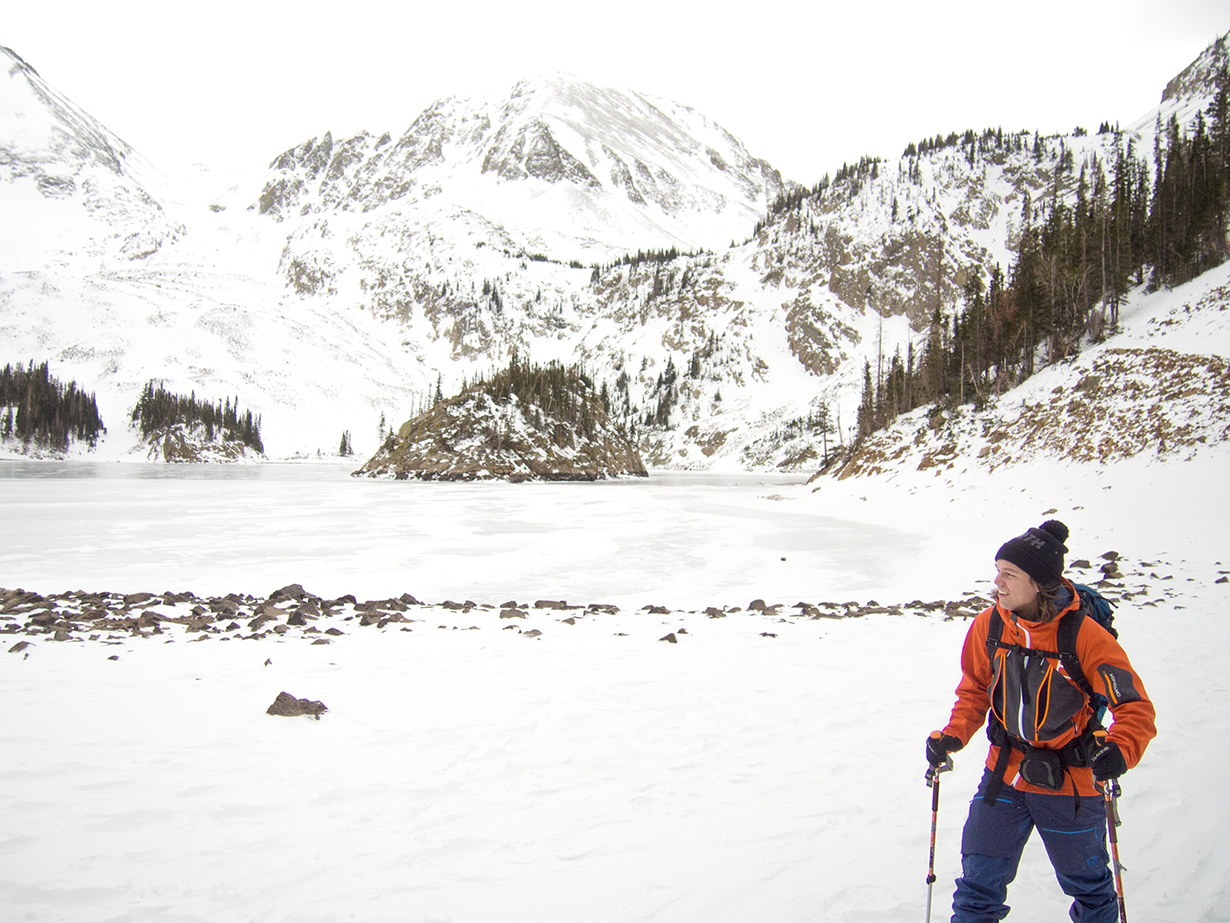
Materials
The Pordoi Jacket’s main fabric consists of a synthetic, stretchy face fabric, a Schoeller c_change membrane, and a merino wool knit backer. The result of this is a very supple fabric that definitely feels more like a soft shell than a hard shell. The hand of the Pordoi’s main fabric feels quite similar to the Polartec PowerShield Pro fabric of the old Patagonia Alpine Guide Pants, and is a bit more supple and significantly thicker than the fabric of the Strafe Recon Jacket. The merino wool backer is pretty soft, though it does have the very slight itchiness of wool when worn directly on skin.
Schoeller says the c_change membrane opens up to increase breathability when your body heat increases, and then closes to preserve warmth when you decrease your activity. I’ll touch on this more in the weather resistance and breathability sections, but I’ve been impressed by the membrane’s performance, though I haven’t noticed a drastic change in performance when I’m working hard and heating up vs. when I’m stationary and cooling down.
The Pordoi also uses a felted wool material with the c_change membrane for the chest and bicep pockets, and uses a similar wool fabric on the chin guard. This fabric is a bit stiffer than the main body fabric, and though I’ve found it pretty comfortable on my chin, it’s not as soft as the microfleece chin guard on the Norrona Lyngen Hybrid Jacket.
Features
The Pordoi has a lot of features, especially for a shell oriented towards touring. Hand warmer pockets, pit zips, two chest pockets, a bicep pocket, and hood / hem adjustments round out a generous feature set.
The hand warmer pockets are low so that they’re comfortable without a pack, but unusable when wearing one since they’re covered by the hip belt (they’re also a bit small for trying to stuff gloved hands inside). The pit zips are fairly small, but the zippers are easy to actuate. The bicep pocket is great for a RFID pass or chapstick, and the hood and hem adjustments do their job — the hood adjusts pretty easily to fit a bare head or helmet comfortably.
I think the asymmetrical chest pockets look pretty cool, but they cause the same issue as the asymmetrical pockets on the Norrona Lyngen Hybrid Jacket — the larger pocket easily fits skins (for 180 cm, 114mm-underfoot skis), but the smaller of the two pockets does not fit the same skins.
The chest pockets on the Pordoi Jacket use the felted wool material (which still has the Schoeller c_change membrane inside). Any sort of fresh snow sticks to the felted wool sections — something that can be annoying on powder days. Despite snow sticking to it, I still haven’t noticed any moisture getting through the fabric.
If you don’t have anything in the chest pockets, they can be opened up and used for further ventilation as they’re only lined with a thin jersey fabric and they open wide when unzipped.
The Pordoi has very minimal, small cuffs with a simple elastic binding and thumb loops. This style of cuff is what I’d expect from a mid layer, but not a shell. If you prefer to use gauntlet-style gloves that go over your shell’s cuffs, the Pordoi’s cuffs won’t be an issue, and the cuff’s thumb loops might even make it better for use with over-the-cuff gloves. However, if you prefer to put your jacket’s cuffs over your gloves, the Pordoi’s cuffs aren’t ideal, and though they can stretch to fit over gloves such as the Hestra Leather Fall Line, the fit is quite tight, and it takes a bit of work to get the cuff over the glove. I think the jacket’s cuffs could be a dealbreaker for people that normally wear their gloves under their jacket cuffs.
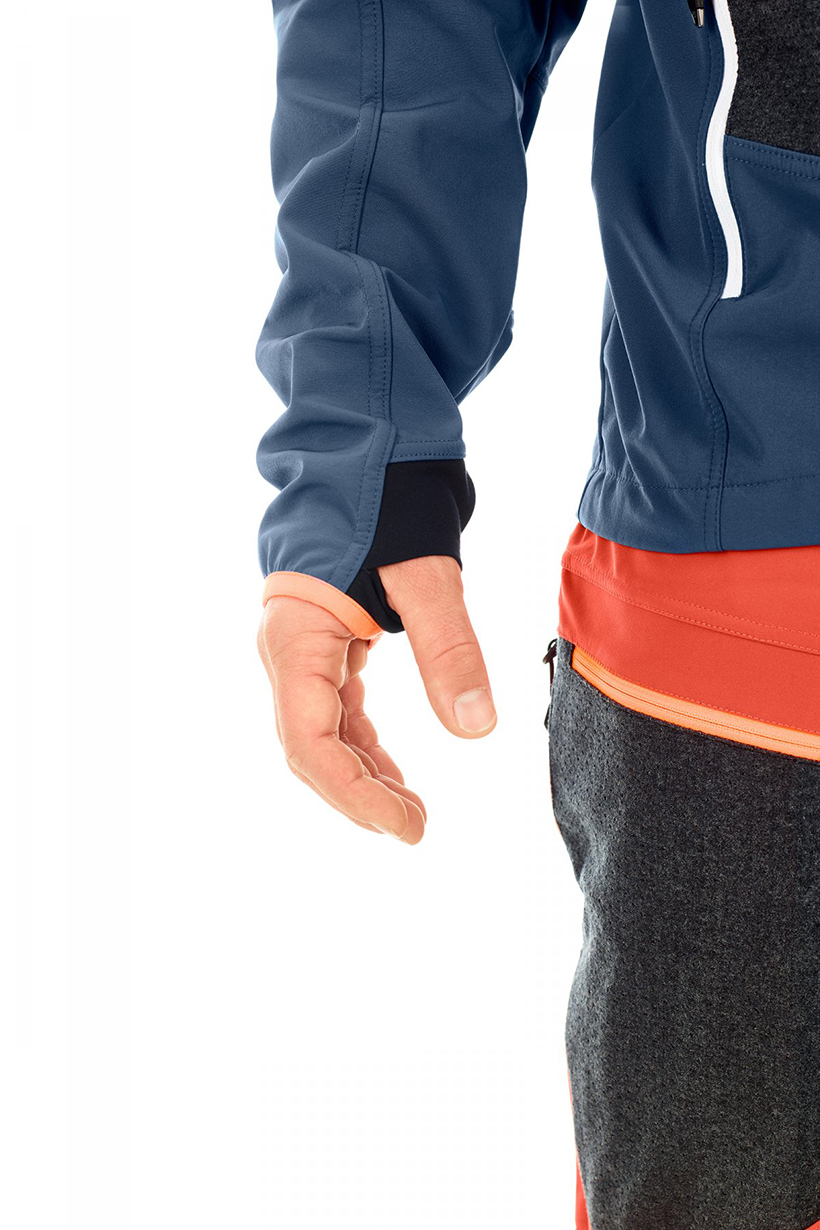
Weight
At a measured weight of 633 grams for a Medium, the Pordoi Jacket isn’t super light, though when you consider all of its features, that weight isn’t all that surprising. The Lyngen Hybrid Jacket comes in at 605 grams, and it lacks hand warmer pockets or a bicep pocket. For reference, the Patagonia Descensionist Jacket (one of our favorite touring shells) comes in at a measured weight of 601 grams in a Medium.
Weather Resistance
Ortovox says the fabric of the Pordoi Jacket has a water resistance rating of over 10,000 mm. If you haven’t already, check out Sam Shaheen’s Outerwear 101 and 201 articles for more information on waterproof membranes and ratings, but basically, 10,000 mm is the level of water resistance that most people consider “waterproof,” and for reference, it is the same water resistance rating of Polartec NeoShell.
I’ve mostly been using the Pordoi in fairly dry snow, and in those conditions, I’ve never had it wet out through to the inner fabric. The DWR has worked well, and the face fabric has only wet out slightly around the waist belt of my pack during a long day of touring while it was snowing all day.
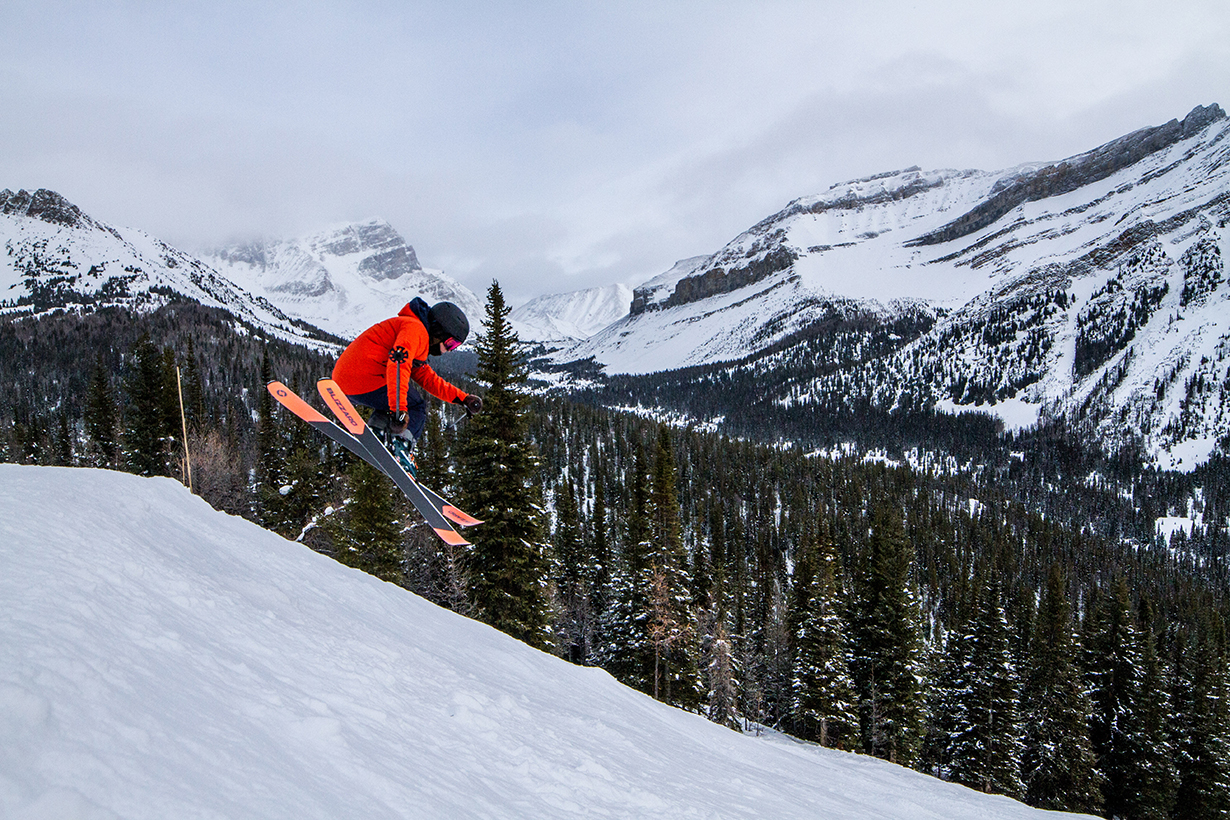
Since I haven’t used the Pordoi a lot in rain / really wet snow, I wore it in the shower to get a better idea of its water resistance, and found that no water got through the main fabric after about 5 minutes in the shower, but I could feel a bit of water coming through the seams as they are not sealed. Though it did well in the shower test, the Pordoi Jacket still wouldn’t be my first choice if I were skiing in wetter climates like the U.S. Pacific Northwest since it lacks sealed seams, but I think its water resistance is more than adequate for drier climates like Colorado.
Ortovox says the Pordoi Jacket is windproof, and I’d agree — I haven’t noticed any wind getting through the Pordoi’s fabric.
Breathability
Given its level of weather resistance, I was impressed by the Pordoi’s breathability. It breathes significantly better than any Gore-Tex pieces I’ve used (including C-Knit, Gore Pro, and standard Gore-Tex). I think the Pordoi breathes slightly better than the Polartec NeoShell fabric on the Strafe Pyramid Jacket, and slightly less than the Norrona Lyngen Hybrid Jacket.
Though everyone’s personal exertion rates and warmth levels vary significantly, I have been able to wear the Pordoi (with just a thin base layer) while skinning at a moderate pace in temperatures up to around 25°F.
Durability
After about 15 days of use, I haven’t had any major durability issues with the Pordoi Jacket. The only thing I’ve noticed is that the elastic binding around the cuff is starting to pill / fuzz a bit. I’ll update this review if I experience any durability issues after getting more days in the jacket.
Who’s It For?
I think the unique style, fit, fabric, and features will be the deciding factors for those considering the Pordoi Jacket. The bright colors and asymmetrical styling make the jacket stand out, and the fit of the Pordoi Jacket is a nice compromise between slim touring shells and baggier freeride jackets. The jacket has plenty of pockets, and the Schoeller c_change fabric offers an impressive blend of water resistance and breathability that’s comparable to Polartec NeoShell. The fabric is also very soft and supple, and definitely does not feel like traditional, crinkly hard shells. The Pordoi Jacket works best with over-the-cuff gloves, and it wouldn’t be my top choice for really wet climates. But if you like the idea of a fully featured shell with a fairly middle-of-the-road fit and a breathable yet weather resistant fabric, I think you’d be happy with the Pordoi Jacket.
It’s also worth noting that, while I’ve been using the Pordoi Jacket mostly as a touring shell, I think people that get along well with it’s fit and features (particularly the cuffs) would be happy using it as a resort jacket as well.
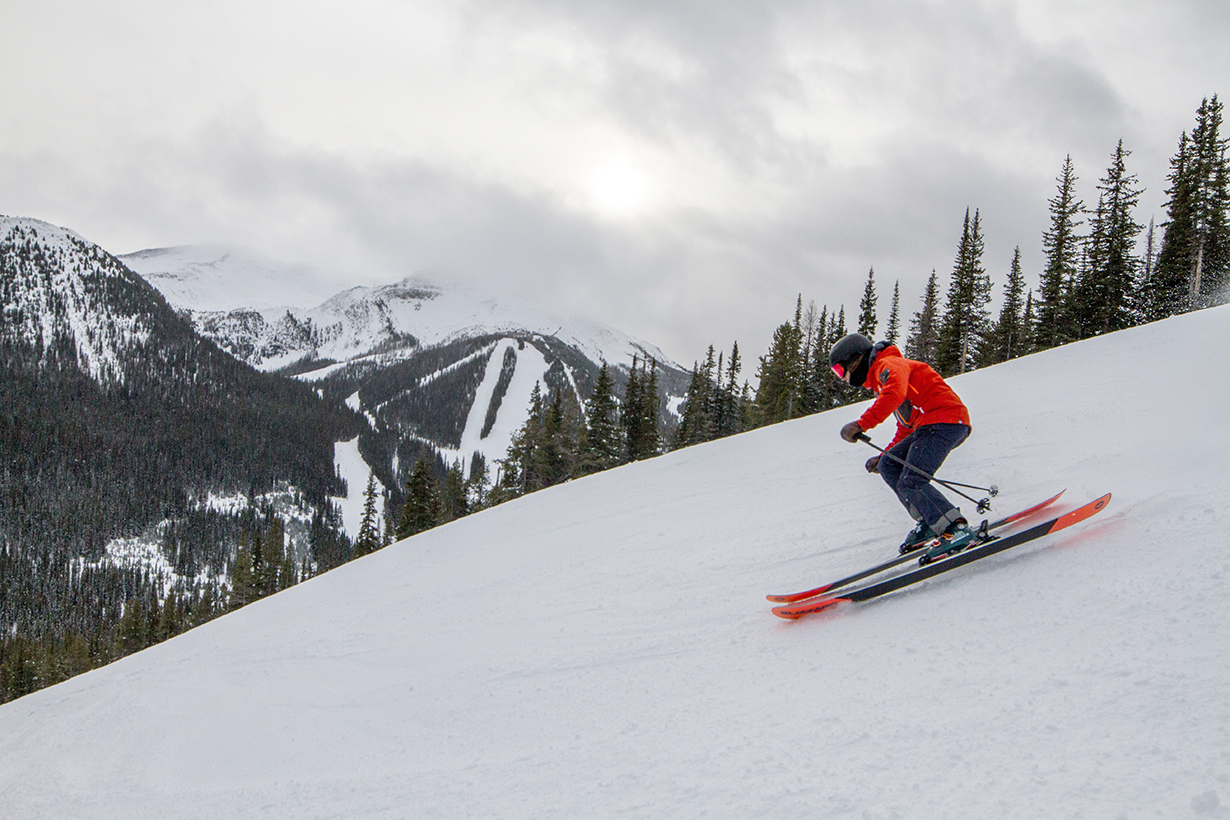
Bottom Line
The Ortovox Pordoi Jacket does a pretty good job of balancing the demands that ski touring places on a shell. It offers plenty of weather resistance for fairly dry climates like Colorado, and it breathes significantly better than traditional hard shells like standard Gore-Tex (and it’s more comfortable). Its asymmetrical wool chest pockets are a bit quirky, and I wouldn’t recommend the Pordoi Jacket to those that like to wear their gloves under their jacket cuffs. But overall, the Pordoi Jacket is a good option for those looking for an all-around touring jacket, and if you like the sound of its features and fit, it’s certainly worth a look.

Hi Luke,
Thank you for your review.
My question Did it keep you warm?
I ski in the northeast about 15 to 20 deg Fair.
Warm Regards,
Rob